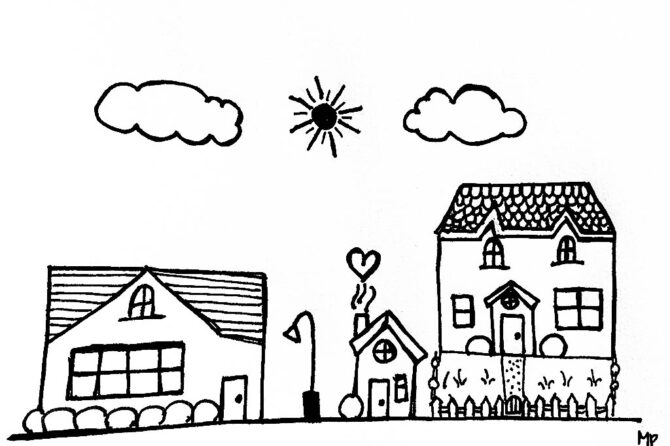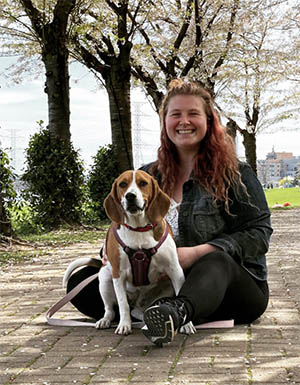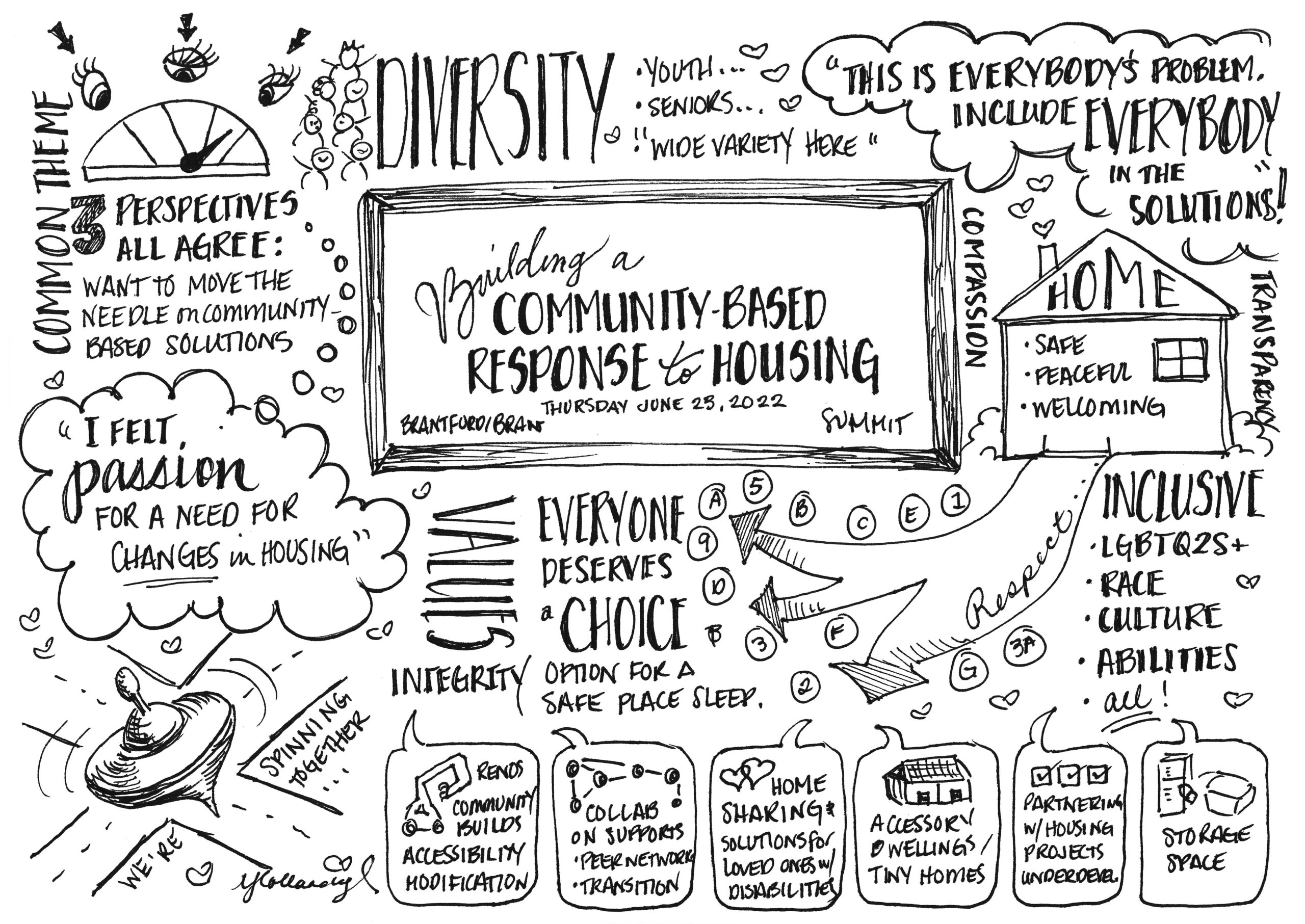
Tiny Home Initiative Underway in Response to Housing Crisis — A Q&A With Jocelyn Birkes
Editor’s note: At a Community-Based Response to Housing Summit earlier this year, Belonging Brant’s Jocelyn Birkes raised her hand to say yes to doing something. In this Q&A, Jocelyn speaks with Peter Pula from the Community Living Brant Narrative Circle about her inspiration to step up, the integral connections she’s made along the way, and what her visions are for the future of housing in Brantford.
Jocelyn, early this summer you participated in a summit to create a community-based response to housing crises in Brant/Brantford. Part of that summit was a Design Café in which community members were invited to put their hand up and name a next step they’d be willing to convene. You put your hand up at the summit. You convened a circle around tiny homes and accessory dwellings. Why is that important to you?
Yeah, it’s exciting. Basically, I felt passionate to get started with the process because during different conversations through Belonging Brant’s work, I met a gentleman who is currently experiencing homelessness. And when we joined him, he shared his story. Through that story sharing, it just came out, how could things be better?
He shared that in other cities, like Kitchener for example, they were doing something called A Better Tent City. He thought incorporating something in Brantford, like tiny homes or accessory dwellings would be beneficial for people who are currently struggling with housing. Through that conversation, we did start a little bit of research. Then I kind of took on more of a lead role, because I have access to resources. I’ve involved him in the process. It became important because through the different housing conversations like in the Housing Summit, and then in the pre- and post-conversations, it seems like it would be beneficial to bring tiny homes, more tiny homes to Brantford, or something similar, like accessory dwellings.
You said you have resources. You have access to resources. Can you say more about that? What do you mean by resources?
Due to the work and the people I know through work, I have access to internet, I have access to computers. And then I have access through partnerships, like Axiom News was a huge one. Community Living Brant. The City has provided options. We now have Jaycee Homes Brantford, like Laurie Macintyre is a huge asset. The library. I’ve included people who work for the City and community members all together. Just bringing people together from the work I’ve already done. So that’s kind of what I meant by resources is just access to them.
(N)ow there’s the people saying yes, figuring out bylaws, figuring out funding, figuring out who to talk to, what is needed, coming up with that vision, mission, and values. Doing the work and getting the feeling that it’s actually making progress has been the most exciting part for sure.
Okay, a network of people who are willing to pay attention.
Exactly. That was one of the things brought up by the gentleman I spoke to initially. How do we get started? There were questions about who to talk to, how to get the funding and having resources in the network, like you said, who to connect to was a huge step in the right direction.
What are you enjoying most about the journey so far?
The people I’m meeting. And, I really love the yeses. It’s great. It’s been really exciting that there has been progress.
It started off with just this one idea where someone experiencing homelessness came up with the idea that, “you know what? This could help. I would consider this beneficial.”
From that idea grew so many other options. It grew like a big network. It just grew. So now there’s the people saying yes, figuring out bylaws, figuring out funding, figuring out who to talk to, what is needed, coming up with that vision, mission, and values. Doing the work and getting the feeling that it’s actually making progress has been the most exciting part for sure.
Okay. You’re saying some of the options have grown. You’ve talked about tiny homes and accessory dwellings. Say more about some of the options you’re seeing as possibilities. You don’t seem to have a single track, you’re still open to what shows up.
Through the different conversations that I’ve had, when the research started, a lot of it showed Better Tent City or Better Street and the different tiny homes, almost like a little community of shelters or tiny homes. So that was one idea, finding a space that could fit multiple tiny homes so people could move in. It doesn’t seem like they’re like long-term homes. They’re more like a place to feel safe and secure, have a lock, key, and door, and then you’d have some support and shared facilities. So that was an option.
(A Better Tent City from Ken Galloway on Vimeo.)
But what I’ve learned and am leaning towards to start with is based on the connections I’ve made. It seems that starting with one tiny home or accessory dwelling would be beneficial as a prototype to do more.
And it’s easier, so far, to find a space to fit one than it would be to fit multiple. So, one of the options is to see about building a tiny home or an accessory dwelling. It can be called either or because it’s just a smaller, more affordable house. But this specific one that we’re looking at, and the construction company were looking at using, would be able to provide a kitchen and a bathroom all included in the one home. It would just be one home that someone could stay in for long term.
So those were different options. It could be multiple dwellings. It could be one. Maybe there’s a possibility, depending on what spacing we can find, to build two or three on the same property, but still make them self-sufficient. That way you don’t need a shared facility or to find a company that will come and do that.
So those are the different options that have been playing in through the research. Opportunities have opened up based on my different conversations. I found that these homes can be beneficial for anyone who’s struggling with housing needs. It’s such a crisis right now. There are so many gaps in the system.
Things are such that anything that’s done is going to be a good thing. That’s the goal: to do something.
This is a community project. It didn’t start with an organization. It started with a community person. Having it continue to be a community project is really the whole goal.
When you look forward, what’s the best the best thing that can happen?
The best thing that can happen is the end product. So, having the one tiny home built, with all these people’s hard work, having the first one built and the first person or family move in. Having one less person struggling is the starting point. That’s where it can all it just grow from there. When you see the story, and you see the start to finish, I think that’s just inspiring in itself. You can build so much from that one starting point.
What steps are you and your small group taking in that direction?
Currently, we are in the midst of having our first convening circle of all the partners I’ve been talking to. We’re going to have our first one at the end of the month. We are going to bring the people who have heard about it and are interested to the same place. Everyone’s thoughts, visions, gifts, and resources can all be in the same room.

Jocelyn Birkes and her dog, Lilly, sitting under the cherry blossom trees at Spencer Smith Park in Burlington.
What would you like, want, or need from the community for this to be as wonderfully successful as it possibly could be?
This is a community project. It didn’t start with an organization. It started with a community person. Having it continue to be a community project is really the whole goal. So, having people join. Let us know of anyone who’d be interested or people who have experience with it or know of other projects. If you have ideas for spaces, or if you have a company that is willing to help build, if you have the financial capabilities of donating a portion, or helping with the grants, or partnering up, all of that would help.
What’s the best thing that could happen?
The best thing that could happen is after the first one, we already have a second one planned. If that happens it shows that there’s even a bigger dream.
In what ways, if any, have you been changed by your experience with this so far?
Oh, I’ve definitely been changed. I’ve never taken on a project like this. Everything I did start to finish has been so brand new, like all this research. I didn’t know about tiny homes to the extent I do now when I first started so that itself was a huge page turner. And then meeting someone and having them share their story, being vulnerable with me. It just changes the way you look at the world and it really shows how powerful and how important making stuff happen is.
It’s not just talking about it. It’s showing that there’s more to it than that. I’ve changed. I’ve changed a lot. My mind has expanded. I became really passionate about this whole project, even though I didn’t even know about it to start, and now that I’m invested in it I know there are people who are looking forward to it.
And there are already people who are interested in this kind of living situation. It just shows that it is a good choice to make, and it was in people’s visions or dreams or goals. Those are so important to share out loud, because you kind of put it out there, and you never know where it’s going to go.
I am so grateful I put up my hand even though it was so scary in the moment. But now, this is actually happening. It wasn’t just a thought that passed. It is coming to fruition.
When you put your hand up at the Housing Summit in the summer, and you started this, what was that like? Did it feel like an act of courage? Or, was it an easy thing to do?
Oh, it definitely wasn’t easy. I was so stressed out. My heart was racing. I didn’t want to actually take on the project, because I didn’t want it to be me. I wanted the person that I met to be the face of it and be part of it the whole way. And even though they’re included in it, they have taken a little bit of a step back.
It was scary because I didn’t want to feel that I was the one doing it because it wasn’t my idea. Giving the credit where credit’s due is really important for me in this whole process. It was scary because of that. But then it was also like, exciting. It was thrilling also to be like, “Oh my gosh, I might as well and see what we can do.”

Graphic reflections sketched live during the June 23 CLB Community-Based Response to Housing Summit by Yvonne Hollandy.
When I put my hand up, I started getting feedback. I started meeting people right away. And I was like, “wow, what am I doing?” And then I started doing research and better questions were coming out of it. Then I started bringing them to the whole group. It just started to piece together one by one. I am so grateful I put up my hand even though it was so scary in the moment. But now, this is actually happening. It wasn’t just a thought that passed. It is coming to fruition.
Amazing. My last question is: What, if any, meaning was made for you through the course of our conversation?
Well, where my mind is going is to the importance of the conversation. Sharing out even further and having people know that this is something that is being worked on, that their ideas are appreciated. Everyone has gifts and making more connections is how it all started. It started with one person bringing it to me. Then, with both of us kind of networking now other people are networking out from there.
It’s all meaningful. Having the conversation is so meaningful. I would definitely take that out of this conversation, the importance of conversation.
Get Involved!
If you have interest in joining this tiny home project, experience in building them, funds or spaces to offer or help access, or if you simply wish to know more, please contact Jocelyn at jocelynbirkes@clbrant.com.
Join the Tiny Homes and Accessory Dwellings Housing Summit!
Join the Tiny Homes and Accessory Dwellings Housing Summit happening Friday, November 4, from 1:00 – 5:00 p.m. To learn more and to register, click here.
Lead image cutline: Artwork created my Marissa Proceviat entitled, “Home Is Where The Heart Is.”
Join our mailing list to to receive a bi-weekly newsletter containing invitations and media related to Community Living Brant.
Leave a reply

Leave a reply